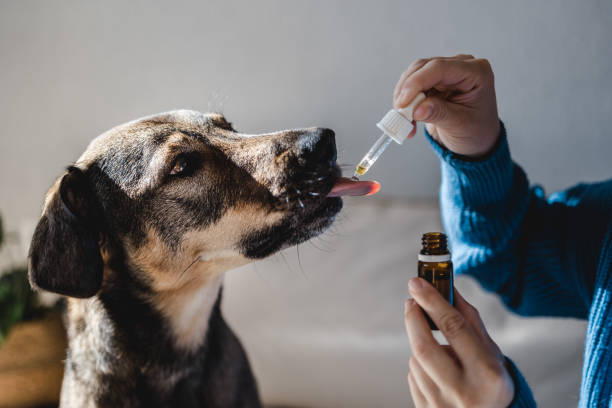Allergies are a common issue in dogs, affecting their comfort and overall health. Understanding canine allergies is crucial for providing the best care for your furry friend. This guide will explore the symptoms, causes, and treatments of dog allergies, helping you identify and manage them effectively.
1. What Are Canine Allergies?
Canine allergies occur when a dog’s immune system overreacts to certain substances, known as allergens. This overreaction can lead to various symptoms and discomfort. Allergies can be caused by environmental factors, food, or even contact with certain materials.
2. Symptoms of Canine Allergies
Recognizing the symptoms of allergies in dogs is essential for timely treatment. Common signs include:
a. Skin Issues:
- Itching and Scratching: Excessive itching and scratching, especially around the face, ears, and paws, are common indicators.
- Redness and Inflammation: Allergic reactions can cause redness, swelling, and hot spots on the skin.
- Rashes and Hives: Raised, itchy bumps or rashes may appear on the skin.
b. Ear Problems:
- Ear Infections: Allergies can lead to recurring ear infections, characterized by shaking of the head, ear scratching, and a foul odor.
- Ear Redness and Swelling: Inflamed and red ears can indicate an allergic reaction.
c. Digestive Issues:
- Vomiting and Diarrhea: Food allergies often cause gastrointestinal symptoms such as vomiting and diarrhea.
- Loss of Appetite: Allergic reactions can lead to a decreased interest in food.
d. Respiratory Problems:
- Sneezing and Coughing: Allergens can cause respiratory issues, including sneezing and coughing.
- Runny Nose and Eyes: Watery discharge from the nose or eyes may occur.
e. Behavioral Changes:
- Restlessness: Dogs may become more restless or agitated due to discomfort.
- Excessive Licking: Persistent licking of certain body parts can be a sign of allergies.
3. Causes of Canine Allergies
Understanding the potential causes of allergies helps in diagnosing and managing them effectively. Common allergens include:
a. Environmental Allergens:
- Pollen: Seasonal pollen from grasses, trees, and weeds can trigger allergic reactions.
- Dust Mites: Tiny dust mites living in household dust can cause allergies.
- Mold Spores: Mold found in damp areas can be a source of allergens.
- Flea Saliva: Flea bites can lead to flea allergy dermatitis, causing severe itching and skin issues.
b. Food Allergens:
- Common Ingredients: Ingredients such as beef, chicken, dairy, and grains are frequent culprits in food allergies.
- Food Additives: Some dogs may react to artificial additives, preservatives, or dyes in commercial pet food.
c. Contact Allergens:
- Certain Fabrics: Materials such as wool or synthetic fabrics can cause skin irritation.
- Chemicals: Cleaning products, shampoos, or topical medications may trigger allergic reactions.
d. Other Allergens:
- Insect Stings: Stings from insects like bees or wasps can cause allergic reactions.
- Medications: Some medications may cause allergic responses in certain dogs.
4. Diagnosing Canine Allergies
Accurate diagnosis is essential for effective treatment. Your vet will typically perform the following:
a. Medical History and Physical Examination:
- Discuss Symptoms: Provide details about your dog’s symptoms, onset, and any potential triggers.
- Physical Exam: Your vet will examine your dog for signs of allergies and other health issues.
b. Allergy Testing:
- Skin Testing: Involves intradermal testing to identify specific environmental allergens.
- Blood Testing: Measures the level of allergen-specific antibodies in your dog’s blood.
c. Elimination Diet Trials:
- Food Trials: Involves feeding a hypoallergenic diet to identify potential food allergens.
5. Treating Canine Allergies
Effective treatment of canine allergies involves managing symptoms and reducing exposure to allergens. Treatment options include:
a. Avoiding Allergens:
- Environmental Control: Reduce exposure to known environmental allergens by keeping your home clean, using air purifiers, and avoiding areas with high pollen or dust.
- Diet Changes: Switch to hypoallergenic or limited-ingredient dog food if food allergies are suspected.
b. Medications:
- Antihistamines: Over-the-counter or prescription antihistamines can help alleviate itching and discomfort.
- Steroids: Corticosteroids may be prescribed for severe allergic reactions to reduce inflammation and itching.
- Immunotherapy: Allergy shots or oral drops may be recommended to desensitize your dog to specific allergens.
c. Topical Treatments:
- Medicated Shampoos: Use shampoos designed to soothe irritated skin and reduce allergens.
- Topical Steroids: Apply prescribed topical steroids to affected areas to reduce inflammation.
d. Flea Control:
- Preventatives: Use veterinarian-recommended flea preventatives to manage flea allergy dermatitis and prevent infestations.
e. Regular Vet Check-Ups:
- Ongoing Monitoring: Regular vet visits will help monitor your dog’s response to treatment and adjust as necessary.
6. Home Care and Management
a. Bathing and Grooming:
- Regular Baths: Bathe your dog with a gentle, hypoallergenic shampoo to remove allergens from the skin and coat.
- Brushing: Regular brushing helps remove loose fur and allergens.
b. Environmental Modifications:
- Clean Bedding: Wash your dog’s bedding regularly to reduce allergens.
- Vacuuming: Frequently vacuum carpets and upholstery to remove dust mites and other allergens.
c. Nutrition and Supplements:
- Omega-3 Fatty Acids: Supplement your dog’s diet with omega-3 fatty acids to support skin health and reduce inflammation.
- Probiotics: Consider probiotics to support digestive health and reduce allergy-related gastrointestinal symptoms.
7. When to Seek Veterinary Help
While minor allergy symptoms can often be managed at home, it’s essential to seek veterinary help if:
- Symptoms Persist: Persistent or worsening symptoms may require professional intervention.
- Severe Reactions: Severe reactions, such as difficulty breathing or anaphylaxis, need immediate veterinary attention.
- Unresponsive to Treatment: If your dog’s symptoms don’t improve with treatment, consult your vet for further evaluation and adjustments.
Conclusion
Understanding and managing canine allergies is vital for your dog’s well-being. By recognizing symptoms, identifying potential causes, and exploring effective treatments, you can help your furry friend lead a more comfortable and healthier life. Regular veterinary care, combined with proactive management strategies, will ensure that your dog remains happy and allergy-free throughout the year.











Leave a Reply